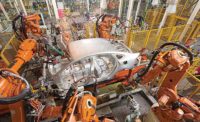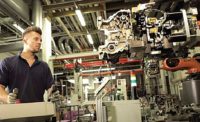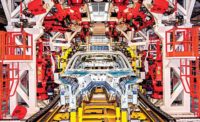Some automotive enthusiasts get their fix by building a car themselves. Others thoroughly enjoy watching the pros do it; i.e., assemblers on the production line. For these folks, the ideal destination is the BMW Group plant in Munich, Germany, where 8,000 employees produce up to 1,000 cars and 2,000 engines daily.
Five days a week year-round, visitors from all over the world are able to take a two-hour tour of this state-of-the-art manufacturing facility. For a fee, people can tour the plant in groups of up to 30. Guides walk visitors through each of the plant’s 12 halls and explain each assembly process in detail in either English or German. Attendees are free to ask questions throughout the tour.
For the last few years, plant visitors have seen a unique helper in the body-in-white (BIW) assembly line: a floor-mounted LBR iiwa cobot made by KUKA AG. This robot places stacks of metal blanks near the shop operator, who uses a fabricating machine to form them into various reinforcement members. The cobot then stacks the finished parts near two larger robots that position each one on the BIW and weld it in place.
Previously, the operator retrieved the metal pieces and stacked the parts. Now, he and the cobot closely interact without protective fences or additional safety components. Their collaboration also increases shop productivity due to a shorter cycle time, enabling the operator to help out at other workstations on the BIW line as needed.
Integrating the cobot into the body shop did present one particular challenge, notes Otmar Honsberg, head of the application engineering team at KUKA Systems. The cobot had to have a footprint small enough to fit into the current shop setup, because the production line could not be modified at all. Fortunately, the LBR iiwa requires only one-fourth the working area of a typical person.
“We had to orient ourselves to the given layout and design an individual solution,” says Honsberg. “As a result, we were unable to use standardized products such as our flexFELLOW [a mobile unit with mounted cobot].” The solution that KUKA engineers did come up with was a series of grippers, each of which enables the cobot to repeatedly and accurately perform a specific production task.
The LBR iiwa cobot is lightweight (less than 30 kilograms), has seven axes of movement and a moderate payload (7 or 14 kilograms). Torque sensors in all joints allow it to detect obstacles in the work area and immediately reduce its speed and force level.
The robot has a maximum reach of 800 or 820 millimeters, depending on the model, and a position repeatability of ±0.15 millimeter. Programming is done via simulation: An operator indicates the desired position, and the robot remembers the path coordinates. Simple touch commands control all movement and stopping.
Rüdiger Weber, a product and process engineer for the BMW Munich plant, is delighted with the cobot and grippers, noting that, together, they provide help and relief to operators in the body shop. He foresees other manual assembly processes at the plant also changing to ones that utilize human-robot collaboration.
“Increasing [workplace] variables and competitive pressure make this human-robot collaboration and flexible solutions unavoidable,” concludes Weber. For more information on collaborative robots, call 866-873-5852 or visit www.kuka-systems.com.








